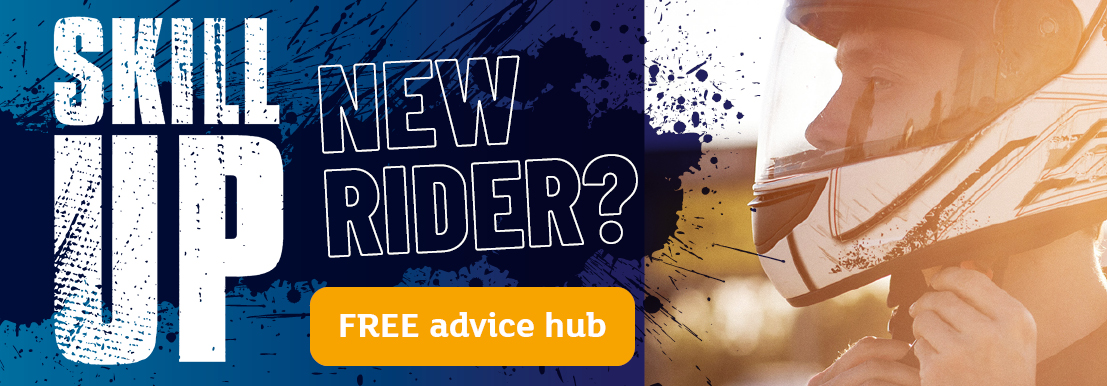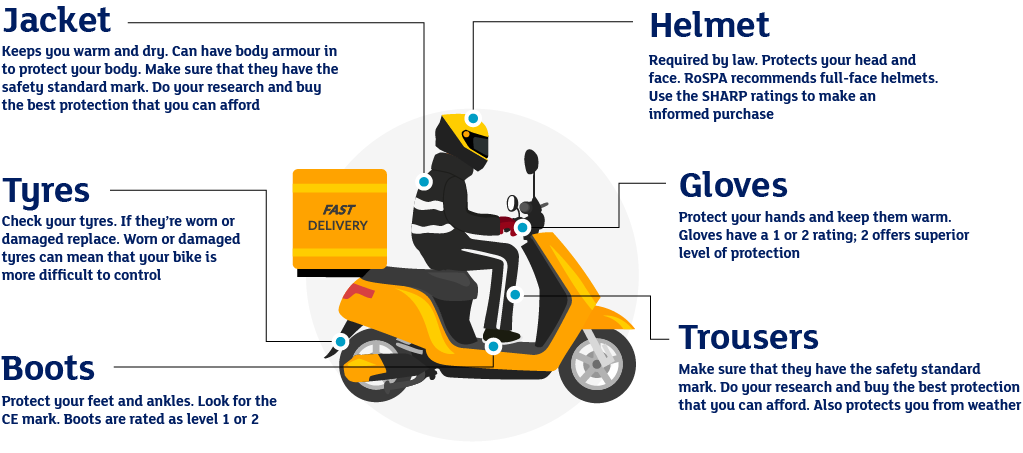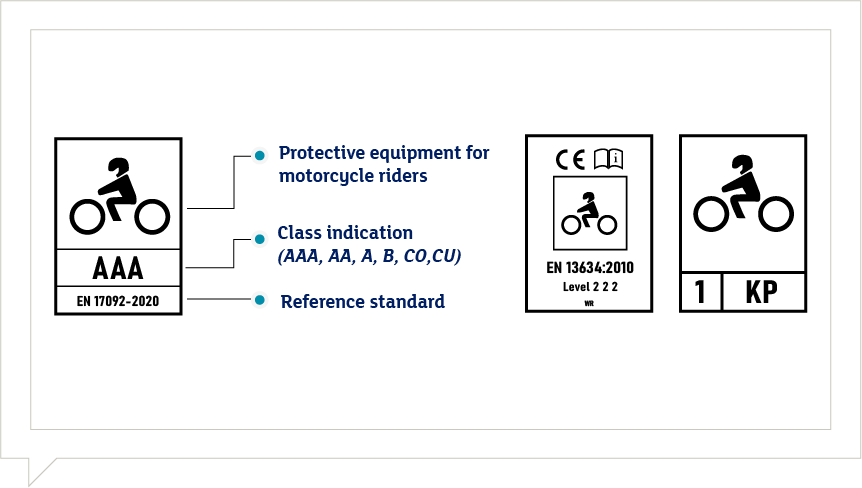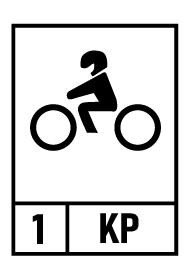
Prepare yourself
Before heading out, it is vital that you are prepared for the ride. One of key ways you can prepare is by ensuring that you are wearing the correct clothing for motorcycling.
If you are buying motorcycle safety gear, RoSPA recommends that you buy clothing with the best protection that you can afford. Ensure that any clothing you buy has a safety label in it, if it is not labelled then there are no guarantees of the products protective qualities.
How do I choose what riding gear I need?
Buying the correct riding gear is vital, as it can prevent and reduce the severity of injury in the event of a collision as well as protecting you from the weather. RoSPA would recommend that you buy the right gear for your needs whilst ensuring that it appropriate for your riding as well as being comfortable. Things to consider would be:
-
Type of motorcycle: The type of motorcycle you ride will determine what gear is appropriate. For example, you will need different gear for riding a scooter in the city than riding a touring motorbike for long journeys
-
Riding conditions: Consider the weather and terrain conditions you will be riding in and choose gear that is appropriate. For example, you may need different gear for hot weather than for cold weather
-
Level of protection: Determine how much protection you need and choose gear accordingly. For example, you may want more protective gear for high-speed riding than for casual riding around town
-
Personal preference: Consider your personal preferences when choosing gear. This may include factors such as the fit and comfort of the gear, as well as its style.
What do I need to think about when buying motorcycle clothes?
-
Safety: Choose clothing that meets safety standards and provides a good level of protection. Look for labels to ensure it has a CE rating
-
Fit: Choose clothing that fits you well and is comfortable to wear. Make sure it doesn’t restrict movement
-
Durability: Make sure your clothing is made of durable materials, look for clothing that is high quality
-
Functionality: Consider the weather and terrain conditions you will be riding in and choose clothing that is appropriate. Look for features such as ventilation, waterproofing, and reflective materials.
What should I wear when riding my motorcycle?

What helmet should I buy?
Your helmet is the main protector of your head and must:
-
be a snug fit and properly fastened
-
have a visor that is clean and clear
-
meet safety standards
-
not be cracked or badly scratched
-
never be cleaned with solvents or petrol as these will damage its structure.
What label should I look out for on a helmet?
Helmets are required by law. They are designed to protect your head and face from injury.
All helmets sold in the UK must meet ECE 22.05, complying with one of these standards:
-
British Standard BS 6658:1985 and carry the BSI (British Standards Institution) Kitemark
-
UNECE Regulation 22.05
-
any standard accepted by a member of the European Economic Area which offers a level of safety and protection equivalent to BS 6658:1985 and carries a mark equivalent to the BSI Kitemark.
You will typically find the ECE 22.05 mark on the rear of the helmet or the strap. From 2021, helmets will begin to show the ECE 22.06 on their safety label, though it’s not until January 2024 that all helmets sold will have to comply with this.
When you buy a helmet, make sure it fits snugly and comfortably. Your helmet will become looser as you wear it, so if it’s already loose when you buy it, it may become too loose with wear and could come off if you are involved in a collision.
The Safety Helmet Assessment and Rating Programme (SHARP) shows you approved helmets and how much protection they offer. RoSPA recommends trying on as many helmets as possible within your price range. Of those that fit correctly and are comfortable, select one with a high SHARP safety (Star) rating.
Do I need a visor or goggles?
A visor or goggles protect your eyes from wind, dust and debris. A visor is a clear or tinted plastic shield that is attached to the helmet. Goggles are separate eye protection that fits over the eyes. RoSPA recommends that you always wear a visor or goggles and ensure that you keep them clean and free from dirt. If you are purchasing visors or goggles, ensure that they comply with one of the following safety standards:
-
a British Standard and displays a BSI Kitemark
-
a European standard which offers a level of safety and protection at least equivalent to the British Standard and carries a mark equivalent to the BSI Kitemark (ECE 22-05)
Keep your visor or goggles clean so that you can see the road clearly all the time. To clean your goggles or visor, wash with warm soapy water and follow the manufacturer’s advice.
If your visor or goggles become heavily scratched, you’ll need to replace them: scratches can distort your view and cause dazzle and glare.
Do I need a motorcycle jacket and trousers?
RoSPA recommends wearing a jacket and trousers designed for motorcycling. Motorbike clothing can be made from leather or a durable synthetic materials, it can also be reinforced with padding. They are designed to protect the body, but can also have other features such as ventilation, reflective materials and waterproofing.
When buying clothing it is important to choose items that fit well and are comfortable. You will also want to think about how and where you ride as this may affect your choices. If your deciding between a few items, at similar price points, always go for the clothing that will give you the greatest protection.
Does motorcycle clothing have a safety rating or label?
All protective riding gear will have a safety standard mark as its guarantee that the clothing offers an appropriate level of protection. This label should be in any clothing that you buy. RoSPA recommends that you buy the best protection that you can afford. For clothing there are various categories of classification:

Class
|
Protection
|
AAA
|
Heavy duty, highest level of protection; protects against impacts and abrasion
|
AA
|
Medium duty protection from impact and abrasion. More suitable for touring motorcycling
|
A
|
Light-duty but can be more comfortable; provides minimum protection against impacts and abrasion. Also suitable for urban riding
|
B
|
Light-duty offers protection against abrasion only. Deemed suitable for urban riding
|
C
|
Impact protectors only. Class C garments should be worn in conjunction with other garments to enhance protection class.
|
Even though it focusses on the Australian market the MotoCAP website does include products that are available globally. MotoCAP, or the Motorcycle Clothing Assessment Program, is designed to provide riders with information on the relative protection and breathability on a range of motorcycle protective clothing.
Is there anything else I should consider when buying clothes?
When buying riding clothes, also consider:
-
Comfort – does it fit and is it comfortable to wear?
-
Visibility – does it help other road users see you in the day and at night? You might wish to have fluorescent clothing for the day and clothing with reflective material for night riding.
-
Weather – does it protect you against the cold and wet?
If you have two garments that you are trying to choose between, we recommend choosing the garment with higher rated protection.
Do I need boots and gloves when riding my motorcycle?
Your feet and hands control your motorbike so it’s important that you look after them when riding. Both gloves and boots offer protection from falls when riding as well as protecting your hands and feet from the weather.
We recommend using boots and gloves becasuse they will:
When choosing your boots and gloves, make sure that they:
-
are made of strong, durable but comfortable material so that you can easily operate your motorcycle controls and levers
-
meet safety standards
-
boots fit above the ankle to protect feet, calves and ankles
-
boots are free of laces to prevent it getting caught in your motorcycle chain.
What are the best boots for riding a motorbike?
Boots will help protect your feet and ankles in the event of a crash and will also improve your grip on the pedals. Trainers won't protect your feet and the laces could become tangled. Look for boots that protect your ankles and provide maximum grip. The best boots for you will depend on the motorcycle you are using and the weather conditions you are riding in.
Motorcycle footwear should be tested to EN 13634:2017. Look for the CE mark on the label. You should also find four digits; either 1 or 2. Level 2 is the higher rating. The digits stand for (in order):
-
Boot height (ankle boots = 1, taller boots = 2)
-
Impact abrasion resistance
-
Impact cut resistance
-
Transverse rigidity (resistance to crushing)
You might also find several acronyms, which are for optional tests:
-
IPA: Impact protection at the ankles
-
IPS: Impact protection at the shins
-
WR: Tested for water resistance
-
FO: Resistance to degradation of the sole through contact with fuel
-
SRA: Slip resistance tested on ceramic tile wetted with dilute soap solution
-
SRB: Slip resistance tested on smooth steel with glycerol
-
SRC: Slip resistance tested on both of the above
-
WAD: Water absorption and desorption of the lining materials
-
B: Water vapour permeability of the uppers
What gloves should I wear when riding a motorbike?
It is important to wear gloves when riding a motorcycle as they will protect your hands from injury and improve your grip on the handlebars. Full-finger gloves provide the most protection, these will be made from leather or another durable material. As well as providing protection in the event of a crash, gloves will also protect your hands from the wind and weather.
Motorcycle gloves should be tested to EN 13594:2015. Look for the CE mark on the label. Motorcycle gloves will also have a '1’ or ‘2’ rating on the label - 2 offers a superior level of protection. In level 1 gloves if you see the KP symbol that means the gloves have knuckle protectors, which are optional. In level 2 gloves, knuckle protectors are mandatory.
